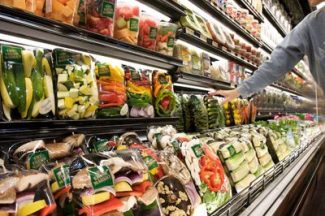5.1 Surround Sound Music & Video – Continental Drift on 3BBR & CRN – Australian Television – Paintings – Design – Cartoons – Animation – Sculpture – Woodcraft

Time to vent on an activity we are all too familiar with.
I've recently relocated house, away from my familiar local supermarket haunt, being a small player competing against a massive duopoly. For sheer convenience, I now (reluctantly) frequent both of the big supermarket players situated close to each other within a huge suburban shopping precinct. (The names have been blurred to protect the guilty.) For several weeks I was forced to take my headphones and loud music with me to shut out the infuriating in-store earworms – their respective advertising "songs" that would be repeated on high rotation. You couldn't escape it. After enduring this torture, either their employees were close to mutiny (bringing swords, eye patches and bandanas to work might have been a clue), or customers started abusing store managers and checkout staff. Irrespective of how the feedback arrived, I've recently been stunned by complete blissful SILENCE: no muzak to turn the dairy case into a vomitorium, no pop songs to rattle my trolley, no jingles or songs to make me abandon my washing powder and run screaming from the store with arms flailing.
If you haven't been paying much attention to pricing, you should. Take a trip on the wild side and visit a fresh food market. You will quickly realise that you are paying a lot more for the convenience of one-stop shopping. Today (in Spring mind you) I saw leg lamb chops for over $46 per kg – outrageous. Last week, whole pumpkins for Halloween were selling for $26 each – that's over $6 per kilo and a complete rip-off!
Pay more attention too to the obvious fact that there is a trend to stock fewer and few brands on the shelves. This is surely deliberate strategy. You might find only 2 or 3 three brand choices for a particular product, and you can be assured that their respective own-brand will be one of them, with the alternatives generally the most expensive. No doubt this is to 'encourage' you to buy their brands, generally no cheaper than the other brands they are NOT stocking. So yet more money goes into their pockets. This also raises a curly question. Are the big stupormarkets now being paid by manufacturers to 'rent' space in the aisles as well as for the prominent display stands in the high traffic areas?
By all means clock up rewards points, but don't be persuaded to exaggerate your purchases to collect extra points. Flyer points are worth a fraction of a cent. A little maths comparing a typical airfare to the cost in points will give you a good idea how much of a con this really is. Qantas for example have admitted publicly that their rewards program is big lucrative business for them. Also, if you're paying around $100 a year for a credit card that accrues reward points, be sure that the value of earning those rewards dramatically outweighs the cost.
Finally, get yourself a copy of the Australian Buying Guide or similar, and learn which brands are foreign owned. Do your best to support Australian producers. Treat them like native fauna. Once extinct (i.e. consumed by multinational conglomerates), they will never come back into Australian hands.




